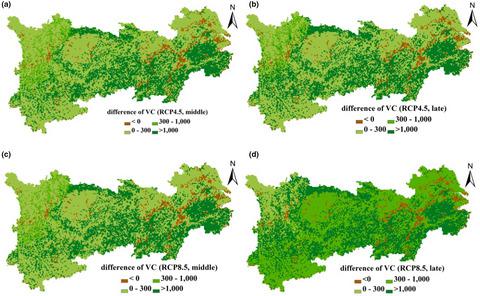当前位置:
X-MOL 学术
›
Ecol. Evol.
›
论文详情
Our official English website, www.x-mol.net, welcomes your
feedback! (Note: you will need to create a separate account there.)
Climate-induced increase in terrestrial carbon storage in the Yangtze River Economic Belt
Ecology and Evolution ( IF 2.3 ) Pub Date : 2021-06-04 , DOI: 10.1002/ece3.7414 Fengxue Gu 1 , Yuandong Zhang 2 , Mei Huang 3 , Li Yu 4 , Huimin Yan 3 , Rui Guo 1 , Li Zhang 3 , Xiuli Zhong 1 , Changrong Yan 1
Ecology and Evolution ( IF 2.3 ) Pub Date : 2021-06-04 , DOI: 10.1002/ece3.7414 Fengxue Gu 1 , Yuandong Zhang 2 , Mei Huang 3 , Li Yu 4 , Huimin Yan 3 , Rui Guo 1 , Li Zhang 3 , Xiuli Zhong 1 , Changrong Yan 1
Affiliation

|
Predicting the change in carbon storage in regions of high carbon uptake and those under highly intensive human disturbance is crucial for regional ecosystem management to promote sustainable development of the economy and ecology in the future. We use a process-based model to estimate the terrestrial carbon storage in Yangtze River Economic Belt (YREB) and to predict the change of carbon storage over the next 100 years. The results show that the vegetation carbon (VC) and soil organic carbon (SOC) storage were 8.97 and 28.85 Pg C in the YREB from 1981 to 2005, respectively. The highest VC density is distributed in the southern region of the YREB, and the highest SOC density distributes in subalpine and alpine area of the western region of the YREB. Carbon storage in the YREB continued to increase from 1981 to 2005 and in future projections, under both the representative concentration pathway 4.5 (RCP4.5) and the RCP8.5 scenarios. The increased rate of carbon storage in the YREB under the RCP8.5 scenario is higher than that under the RCP4.5 scenario. Under the RCP4.5 scenario, the increasing trend of VC storage tends to be reduced after the 2060s; conversely, the increase of both VC and SOC is accelerated after the 2050s under the RCP8.5 scenario. The SOC density in Western Sichuan will decrease in the future, especially under the RCP8.5 scenario. Western Sichuan has the highest SOC density in the YREB; therefore, it is important to manage the ecosystems there in order to cope with significant warming. The positive impact of warming and the CO2 fertilization effect on vegetation growth and carbon uptake will be predominantly attributed to the increase of terrestrial carbon storage in the YREB. However, warming will stimulate the decomposition of soil organic carbon, contributing directly to reducing SOC storage in high-altitude regions (e.g., alpine and subalpine regions of Western Sichuan).
中文翻译:

气候导致长江经济带陆地碳储量增加
预测高碳吸收区域和人类高度干扰区域的碳储量变化对于区域生态系统管理、促进未来经济和生态的可持续发展至关重要。我们使用基于过程的模型来估算长江经济带(YREB)的陆地碳储量,并预测未来100年碳储量的变化。结果表明,1981-2005年长江经济带植被碳(VC)和土壤有机碳(SOC)储量分别为8.97和28.85 Pg C。 VC密度最高分布在长江经济带南部地区,SOC密度最高分布在长江经济带西部亚高山和高山地区。从 1981 年到 2005 年以及未来的预测,在代表性浓度路径 4.5 (RCP4.5) 和 RCP8.5 情景下,长江经济带的碳储存持续增加。 RCP8.5情景下长江经济带碳储量增幅高于RCP4.5情景下。 RCP4.5场景下,2060年代后VC存储增长趋势趋于减少;相反,在RCP8.5情景下,2050年代以后VC和SOC的增长都加速。未来川西地区SOC密度将会下降,特别是在RCP8.5情景下。长江经济带川西地区SOC密度最高;因此,管理那里的生态系统以应对显着变暖非常重要。变暖和CO 2施肥效应对植被生长和碳吸收的积极影响将主要归因于长江经济带陆地碳储存的增加。 然而,气候变暖会刺激土壤有机碳的分解,直接导致高海拔地区(如川西高山和亚高山地区)土壤有机碳储存量的减少。
更新日期:2021-06-22
中文翻译:

气候导致长江经济带陆地碳储量增加
预测高碳吸收区域和人类高度干扰区域的碳储量变化对于区域生态系统管理、促进未来经济和生态的可持续发展至关重要。我们使用基于过程的模型来估算长江经济带(YREB)的陆地碳储量,并预测未来100年碳储量的变化。结果表明,1981-2005年长江经济带植被碳(VC)和土壤有机碳(SOC)储量分别为8.97和28.85 Pg C。 VC密度最高分布在长江经济带南部地区,SOC密度最高分布在长江经济带西部亚高山和高山地区。从 1981 年到 2005 年以及未来的预测,在代表性浓度路径 4.5 (RCP4.5) 和 RCP8.5 情景下,长江经济带的碳储存持续增加。 RCP8.5情景下长江经济带碳储量增幅高于RCP4.5情景下。 RCP4.5场景下,2060年代后VC存储增长趋势趋于减少;相反,在RCP8.5情景下,2050年代以后VC和SOC的增长都加速。未来川西地区SOC密度将会下降,特别是在RCP8.5情景下。长江经济带川西地区SOC密度最高;因此,管理那里的生态系统以应对显着变暖非常重要。变暖和CO 2施肥效应对植被生长和碳吸收的积极影响将主要归因于长江经济带陆地碳储存的增加。 然而,气候变暖会刺激土壤有机碳的分解,直接导致高海拔地区(如川西高山和亚高山地区)土壤有机碳储存量的减少。











































 京公网安备 11010802027423号
京公网安备 11010802027423号